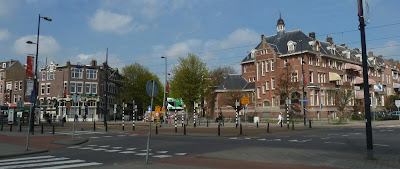The walk and the questions
Last spring my wife and I walked the Jeneverpad - a well documented walk from Rotterdam to Maasluis, with it's own walking guide. The booklet gives some background information about the places we visit. But more questions are raised during the walk than can be answered. Part 1, part 2, part 2b.
Roemer Visscherstraat - Standard residential area. High density housing on the left, high density education on the right. Nameless canal and default greenery in between. Pleasant narrow path along the water. Leaving the city, entering artificial nature.
Nivonpad towards Krabbeplas - Artificial nature from the 1990's. On the left Golf-Area Schinkelhoek, freegolf - smaller balls, shorter trajectories, saves valuable space. Buttercup, cow parsley, rapeseed. The beautiful spring highway colours: grey, green, yellow, white and blue.
Thinking about the Von Thünen model - concentric rings of: city, gardening, forest, grain, ranching, wilderness. Could it still work? He didn't include leisure spaces in his model. Remains of a bronze age man were found in this area. He was both 43 years old and 3300 years old. I wish I had known this during the walk, I would have looked with different eyes.
The view over the Krabbeplas - Maasland with it's obligatory Protestant church (on the right, 1400) and Catholic church (on the left, 1886). No trace anymore of the important, but mostly forgotten Battle of Vlaardingen (1018). Impossible now to imagine knights in armor. You could play a Marcel Proust game with the church towers.
Zuidbuurt - Looking toward the garbage incineration plant on the other side of the river. Heavy industry is closer that one would think. You could also play a Marcel Proust game with these industrial chimneys.Zuidbuurt - Pollarded ash trees. It is quite rare to see those. Traditional and ancient creatures.
Zuidbuurt, Recreatiepad - Contrast between old and new landscapes. Old and new trees.Binnenbospad - The nature reserve Oeverbos has been constructed on top of heavily polluted soil that was dredged from the Rotterdam harbor (drins - the now banned chlorinated insecticides). Nature does not mind and neither do the large groups of immigrants that enjoy the free weekend and their large-family barbecues.
Oeverbospad - The beautiful silver poplar (Populus Alba) was brought to The Netherlands in the 17th century. Even in summer the rustling leaves create an autumnal atmosphere.
Oeverbospad - The mysterious pipe storage. These are only the last remains. Where did the rest go?Burgemeester van der Lelykade - Gemaal Mr. Dr. C.P. Zaayer, a beautiful art-deco pumping station from 1926. It was designed as a diesel pumping station. Today it has modern electric pumps that can transport 2.2 million liters per minute.
Maasluis harbor - A beautiful cityscape from around 1650. The town has a rich history but today it is mostly a commuter town for Rotterdam.
Most important lesson from the walks:
- The sometimes bland landscape hides a rich prehistoric and medieval history.
- The old history is mostly invisible. Only from the 1600's onward you really start to see it.
- Today the landscape has been homogenized. In earlier times it was a more interesting mosaic of small towns with their industries and their struggles for influence.
References:















































